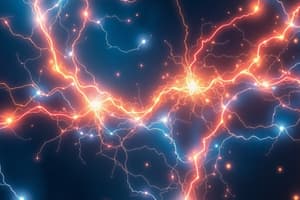Podcast
Questions and Answers
What does Ohm's law state?
What does Ohm's law state?
- The current through a conductor is directly proportional to the resistance across the two points.
- The current through a conductor is directly proportional to the voltage across the two points. (correct)
- The resistance across a conductor is directly proportional to the voltage through it.
- The voltage across a conductor is inversely proportional to the current through it.
How is resistance related to the flow of electric current?
How is resistance related to the flow of electric current?
- Resistance has no impact on the flow of electric current in a conductor.
- Resistance increases the flow of electric current in a conductor.
- Resistance stops the flow of electric current in a conductor.
- Resistance decreases the flow of electric current in a conductor. (correct)
What does resistance measure?
What does resistance measure?
- The opposition to the flow of electric current in a conductor.
- The ease of passing an electric current through a material. (correct)
- The amount of current it can carry.
- The voltage required to drive that current.
In an electric circuit, what are circuits used for?
In an electric circuit, what are circuits used for?
How can Ohm's law be mathematically expressed?
How can Ohm's law be mathematically expressed?
What is the main difference between series and parallel circuits?
What is the main difference between series and parallel circuits?
What is the unit of measurement for electric current?
What is the unit of measurement for electric current?
What is the direction of electric current defined as?
What is the direction of electric current defined as?
What is EMF (Electro Motive Force) a measure of?
What is EMF (Electro Motive Force) a measure of?
According to Ohm's law, what is the relationship between current, voltage, and resistance?
According to Ohm's law, what is the relationship between current, voltage, and resistance?
Flashcards are hidden until you start studying
Study Notes
Current Electricity
Electricity is a form of energy that is used to power various devices and appliances in our daily lives. It is crucial to understand the concepts of current electricity, including Ohm's law, resistance, circuits, electric current, and EMF (electro motive force), to better comprehend how electricity works and how it can be harnessed for our needs.
Ohm's Law
Ohm's law is a fundamental principle in the field of electricity that states that the current through a conductor between two points is directly proportional to the voltage across the two points, and inversely proportional to the resistance between them. Mathematically, this can be expressed as:
V = I * R
where:
- V is the voltage,
- I is the current,
- R is the resistance.
This relationship allows us to calculate the current flowing in a circuit given the voltage and resistance, or the voltage across a circuit given the current and resistance.
Resistance
Resistance is the opposition to the flow of electric current in a conductor. It is a measure of the difficulty in passing an electric current through a material. Ohm's law tells us that the current through a conductor is directly proportional to the voltage across it, and inversely proportional to its resistance. This means that the resistance of a conductor determines the amount of current it can carry, and the voltage required to drive that current.
Circuits
Electric circuits are used to control the flow of electric current for various purposes. There are two main types of circuits: series circuits and parallel circuits. In a series circuit, the components are connected end-to-end, and the same current flows through each component. In a parallel circuit, the components are connected in parallel, allowing the current to divide and flow through each component.
Electric Current
Electric current is the flow of electrons in a conductor. It is measured in units of amperes (A), and is usually represented by the symbol 'I'. The direction of current is defined as the direction in which positive charges would flow.
EMF (Electro Motive Force)
EMF, or electromotive force, is the force that drives electric current in a circuit. It is a measure of the potential energy available in a circuit to do work. The EMF of a cell is the voltage that it produces when it is fully discharged. The relationship between EMF, current, and resistance is given by Ohm's law, which states that the current through a conductor is directly proportional to the voltage across it, and inversely proportional to its resistance.
In conclusion, understanding the principles of current electricity, including Ohm's law, resistance, circuits, electric current, and EMF, is essential for designing and operating electrical systems. By applying these concepts, we can effectively control and harness the power of electricity for our daily needs.
Studying That Suits You
Use AI to generate personalized quizzes and flashcards to suit your learning preferences.




